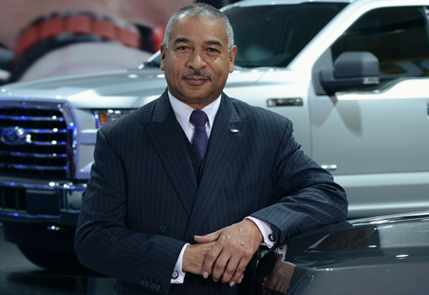Sustainability Report 2013/14
Year in Review
Letter from Robert Brown

The companies that thrive in the 21st century will be those that best align their business with key global sustainability challenges. At Ford, sustainability is an integral part of the One Ford plan that drives our business. A key theme of my work at Ford is making sure that sustainability remains at the heart of our strategy and that we take the practical steps needed to continue to integrate sustainability into our business processes. Two recent examples bring our integration strategy to life.
The first example is how we’re managing sustainability during an unprecedented global expansion. As we introduce new products, build new world-class facilities and expand existing operations, we are leveraging our accumulated experience and best practices. We are developing centers of excellence in Asia Pacific and other regions, and better linking people who have sustainability responsibilities throughout the company. Our centers of excellence provide input to practical targets associated with specific time frames. Ford’s science-based climate goal is to contribute to stabilizing carbon dioxide (CO2) concentrations in the atmosphere at a level that avoids the most serious consequences of climate change.
Second, the reinvention of the 2015 Ford F-150 pickup truck demonstrates our integrated approach and how capability and efficiency do not have to be mutually exclusive. The redesign of the F-150 was driven by the needs of our loyal customers for a tough and capable next-generation truck. At the same time, the new F-150 is a step forward in our Blueprint for Sustainability. We took one of our largest vehicles and went to great lengths to deliver improved capability while reducing weight to enhance efficiency and performance, setting a new industry standard in the process. We accomplished this through new applications of high-strength steel and aluminum alloys, which not only reduce weight but also improve the dent resistance and overall durability of the truck body. The materials were rigorously tested and analyzed for durability, overall performance and lifecycle environmental impact. For a closer look at the new F-150, please see Case Study: The Future of Pickup Trucks.
Below are some additional sustainability highlights.
Financial Health
Ford has delivered five successive years of positive net income, driven in part by our sustainability strategy and our commitment to great products that are high quality, green, safe and smart. That’s why last year’s sustainability report was introduced by Bob Shanks, our Chief Financial Officer. When he emphasized the importance of sustainability to the company’s financial health, it got people’s attention. This report was introduced by John Fleming, executive vice president, Global Manufacturing and Labor Affairs, with a focus on water strategy.
Climate Change
We continue to implement our Sustainable Technologies and Alternative Fuels Plan, although the energy landscape has changed significantly since we launched it. In particular, unconventional oil and gas development in North America has increased supplies and eased energy costs in the region. This may have contributed to a dip in our overall U.S. average fleet fuel economy in 2013. Despite improvements in both our truck and car fuel economy, more trucks were purchased, which drove down the overall average.
To help customers meet their own fuel economy goals, we developed a very sophisticated analytical application that provides in-depth information to fleet buyers. The analytical application provides data about choices available, life cycle ownership costs, the timing of costs and savings, and the amount of CO2 emissions they can avoid by choosing efficient and alternative fuel vehicles.
Water
In early 2014, Ford endorsed the United Nations CEO Water Mandate, and we have built our comprehensive water strategy around its core elements. The strategy reflects our integrated approach. It focuses on using water efficiently in our operations. It also includes working with our supply chain and engaging with stakeholders and policy makers. We integrate our volunteer and grant-making programs, directing their efforts to address water challenges in the communities in which we operate.
Reflecting the importance of the water issue to Ford, a cross-functional team from across Ford divisions – including our Environmental Quality Office and our Manufacturing, Purchasing, Research and Community Relations functions – reviews water issues in a holistic way, while our Board of Directors reviews our water-related progress yearly.
Vehicle Safety
We seek to make advanced safety and driver assist features available on widely available products. For example, our Rear View Camera, which transmits an image of what is behind the vehicle when it is shifted in reverse, is available on every Ford and Lincoln vehicle in North America. In Europe, it is offered on the Ford Focus, B-MAX, C-MAX, S-MAX and Kuga.
We also know that safety involves more than technology. That’s why our Driving Skills for Life program is now operating in 16 countries. While in some countries the program is aimed mainly at young, novice drivers, in others we encourage the participation of new drivers of all ages.
Supply Chain
Ford has long understood our reliance on the sustainability of our supply chain. We have been a leader in promoting sound working conditions and environmental management across the automotive supply base. These efforts are managed by and integrated into our Purchasing function.
In 2013, we continued to advance our efforts to ensure the minerals in our products are sourced responsibly. We assessed the presence of these minerals through the many tiers of our supply chain. We also collaborate with other automakers and other industries to encourage mineral smelters and refiners to become certified conflict free.
In summary, it is an exciting time in our industry and our company. Our approach to sustainability has served us well as we have grown and expanded. And I expect that our integrated systemic approach to sustainability will provide the platform for addressing future issues like automated vehicles, urban congestion and mobility for today’s underserved. Many opportunities are before us, and I welcome your feedback on our performance.
![]()
Robert Brown
Vice President, Sustainability, Environment and Safety Engineering
June 2014
© 2014 Ford Motor Company